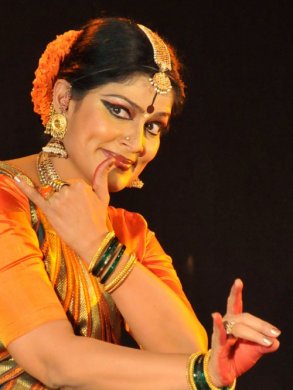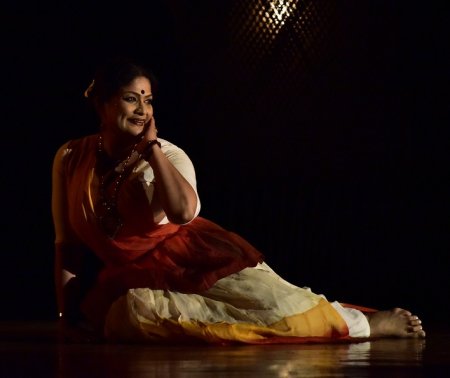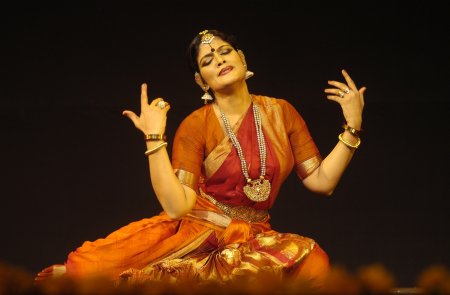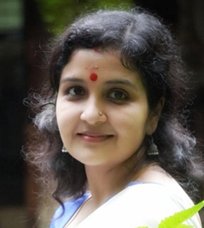
|
 |

|
 |
Geeta Chandran: Endance the universe - Aparna Vasudevan e-mail: aparnavg4@gmail.com May 15, 2022 A celebrated artiste and a star performer, Geeta Chandran is synonymous with Bharatanatyam. Today, even as she marks over four decades of engagement with Indian classical dance since her arangetram in 1974, Geeta Chandran has evolved to become a renowned artist who has synthesised the knowledge she received from her stalwart gurus to imprint Bharatanatyam with her personal vision of the dance. In her dance presentations, Geeta Chandran skilfully weaves abstract notions of joy, beauty, values, aspirations, myth and spirituality. Geeta is the artistic director of Natya Vriksha Dance Company known for the high aesthetic quality of its group presentations. In the book Dynamic Women Dancers (women's hall of fame series), Canadian author Anne Dublin listed Geeta Chandran as one of the ten global "all-time great dancers." Here Geeta Chandran speaks about her dance journey.  Geeta Chandran in 'Sarvam Krishnamayam' Photo: Sarabjit Singh Dhillon When did you realise that dance is your calling? Hailing from a family which was very focused on education, academics was very important for my parents. But they were also connoisseurs of art, so they used to take me to concerts of dance and music right from my young age. Then with academics I started to learn dance at age of 5 and music at 7. I was blessed to have a structured upbringing with academics, dance, music, sports etc. I think all this created a passion in arts. It was much later after I finished my PG in communication, I tried to multitask and then realised that I wanted to get into all aspects of dance, music, theory, rhythm, mythology, poetry, philosophical aspects etc. When I came to realise that I couldn't multitask, I gave up my job. You could say that was my turning point when I decided to take dance as my life. How do you define your style, which bani do you follow? I started with Thanjavur style with Swarna Saraswathi amma. Then I moved to Dandayuthapani Pillai style with Dakshinamoorthy sir. The two were completely different, so when I combined the two, one can say that it was best of both vibes. Thanjavur style is an extremely internalised, spiritual experience and the other was outward manifestation of that to be able to communicate to audience and performance oriented. I think I was blessed to have both these different kinds of tutelage and I tried to synergise that with of course element of abhinaya from Jamuna Krishnan and Kalanidhi Narayanan from where I studied music connection to abhinaya. Combining these three streams together helped me to develop my dance learning. I think intelligence lies in how you synergise when you learn something and how the body absorbs the tutelage and make it your own. Today I see many students doing workshops under many gurus and ultimately become confused. So, if you don't have the intelligence to synergise or synthesise what you are learning from different people, then it becomes a patchy kind of work and one is not able to see holistic personal interpretation in dance. Tell us about your institution Natya Vriksha... When I was teaching in Delhi, different kinds of students were coming to learn dance, who are non-south Indians, not really from a background of dance, not really connecting with any kind of cultural background. So, I realised that there were lot of gaps in really connecting in terms of mythology, philosophy, aesthetics etc. In all these, I educated myself separately apart from my teacher's lectures. I thought that is important to bring all these to the pedagogy of dance, because dance is not only movement of hands and legs. I guess Natya Vriksha gives that kind of space to students. We discuss psychology, problems in the field of performing arts, journalism, music etc. Now we have completed 32 years of Natya Vriksha. We are also giving art awareness to parents because many times they are the stumbling block to students who want to take dance seriously. Natya Vriksha was my dream when I started as to what I should be doing. Definitely it is an engaging journey. Which bhava do you like the most for expression? I think it is 'shringara' because it is the rasaraja and it brings everything under that, so it is very close to my heart. Bhakthi bhavam holds the second. I do dance a lot in bhakthi mood and made lot of compositions based on that. Shringara and bhakthi are two main pillars, in that everything comes. You are also a trained musician and have composed lot of pieces. How important is music knowledge to a dancer? We cannot dance without knowing music. I feel that musicality in dance is significant. It is not only restricted to padams and javalis but in jathis also. I think musicality, tenderness and aesthetic quality of a movement is trivialised today. There must be some connection with movement and chollus. Musicality in dance is not only about abhinaya and interpretative dance but general musicality in body; even when you walk back it has a sense of music. If the musician is doing an extraordinary sangathi, the dancer has to react to it positively or else it may be just like a robot dancing. I think there will be no rasa there. I give lot of space to my artistes to improve that musicality in performance.  Geeta Chandran in 'Gandhi: Warp and Weft' Photo: Rakesh Sahai You have acted as 'Simhika' (character in Kirmeeravadham Kathakali) in Kerala Kalamandalam recently. How does it differ from the original character? When organisers approached me with this character 'Simhika', I asked them whether I can take some liberty. Then I read the play, discussed with Kathakali aasan, researched more on the particular character. I always try to connect to society and current situation. I called 'Simhika' a daughter of the forest. I started the performance as a flashback that she is sitting and lamenting about the past. She may be a rakshasa but she is a woman. She is completely disfigured. Here it is very easy to punish a woman by defacing and taking away their identity. Simhika is a black and white character. More work and research should be done to improve the piece. I think it will have a contemporary take. What is the significance of social responsibility of an artiste in our society? I think it is a personal take, many people think that they can only dance. But in my opinion why should dance always be seen as that which is old, historical, conventional art as its vocabulary doesn't say that. I just feel dance is evolving with time. I think we can address social issues with the same vocabulary of dance but it's very challenging. Tell me something about your mission, "Endance the universe." I think dance needs to reach people who have never witnessed and never engaged with it. So I look for audience like that and I think my challenge is not to go to very initiated audience. As I am staying in the north, there are lot of audiences which we need to reach through the arts. I go to remote schools and colleges for that. Their response is very gratifying. These are the important things that matters to me. When you sow the seed for sometime, it may not immediately materialise but later that connection happens. That is 'Endance the universe.' Universe is not only Sabhas of Chennai but much much beyond that. What is your notion of making a presentation interesting to the audience? I create dance craft depending on what kind of audience and what kind of space we are dancing in. When we are performing in a public space you need to craft it in a way that it may not be too slow. If there is a moving kind of audience you have to select an item which is very eye catching then people will come, sit and see, so you need to understand the audience first.  Photo: Avinash Pasricha How did your family help you in this dance journey? Arts needs support. Initially, my parents were my pillar of support. After that Rajiv, my husband, stood with me. Then I became a teacher and my students became my strength. They take administrative and teaching works and they also assist me in choreography. Now they are my family, they are my strength. As a guru what are the most significant qualities apart from the dance itself that you strive to instil in your students? You can't preach what you don't practice. If I am not punctual, I can't expect my students to be punctual. I think discipline needs to be instilled by practicing it. A Guru needs to do that first. Apart from discipline, organising and planning skills are also very important. Moreover, systematic approach in learning and researching make our productions more beautiful. What is your opinion about performing arts through digital platform or digitalisation in teaching and performing? I think there was no option during pandemic situation, so it was good to engage in it at that time and we could reach people anywhere in the world. But regarding online performances, I do not really enjoy that because I feel that the connect with the audience is not there. Just dancing to the camera is sterile I feel. Live experience is something very very different. I think we can balance these things and there are some things we can do through online, like illustrated talks, abhinaya workshop etc. We are still figuring out how technology can help performing arts. Live experiences of teaching, learning, performing can't be taken away by technology. Something can be added, nothing can be replaced.  Based in Kozhikode, Aparna Vasudevan is a performer of Bharatanatyam and Kathakali, an educator and researcher. Post your comments Please provide your name and email id when you use the Anonymous / blog profiles to post a comment. All appropriate comments posted with name and email id in the blog will be featured in the site. |